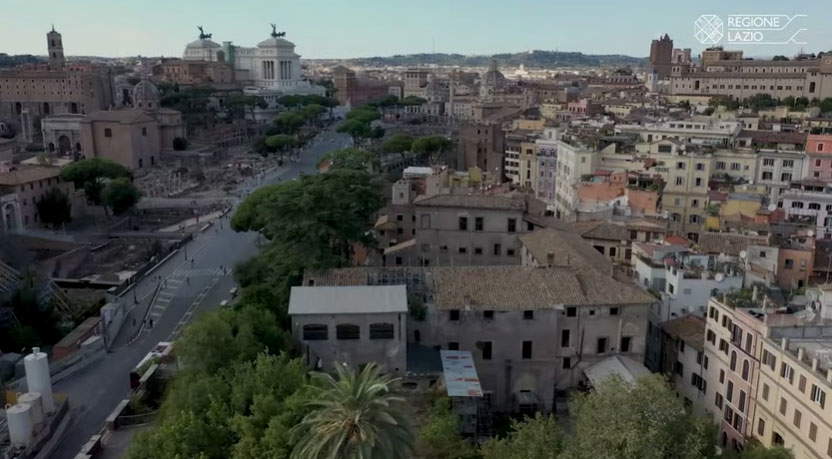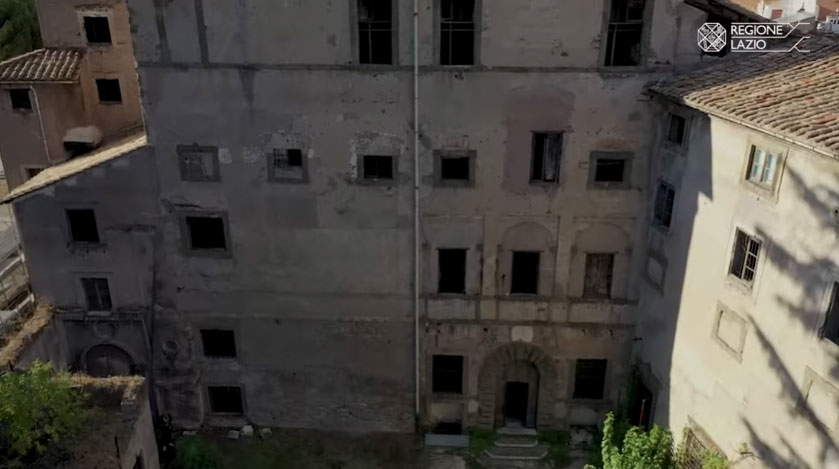The future of Palazzo Silvestri Rivaldi, one of the largest and most important architectural complexes in Rome ’s historic center (it occupies an area of one hectare), currently in a state of decay and abandonment, is beginning to take shape. On Friday, Culture Minister Dario Franceschini and Lazio Region President Nicola Zingaretti signed an agreement for the redevelopment, renovation, re-functionalization and return to the public of Palazzo Silvestri Rivaldi. Currently, the complex is owned by the Azienda di Servizi alla Persona ISMA Istituti di Santa Maria in Aquiro.
A Renaissance-era building, located in the archaeological area of the city of Rome, it spreads over three of the best-known streets in the center of the capital: Via del Colosseo, Via dei Fori Imperiali, and Via del Tempio della Pace. The complex consists of an older palace built between 1534 and 1549 for Eurialo Silvestri, Pope Paul III’s valet, on an initial design by Antonio da Sangallo with an entrance from Via del Tempio della Pace and Via del Colosseo; a residential villa with access from Via del Colosseo; and a park with an entrance from Via del Colosseo and Via dei Fori Imperiali. The latter access is highlighted by a communal belvedere terrace, enhanced by architectural and sculptural elements such as nymphaea and statues. The complex also features archaeological areas already identified by the Superintendence relating to the remains of a Roman villa of the 1st century AD; the villa and the Palace are in direct contact by means of the park, which is accessed through the round-arched entrance portal located along Via del Colosseo. Inside the palace are frescoes on the walls and vaults, attributed to Perin del Vaga. The 1676 plan is particularly valuable because, behind the palace on the street, it bears witness to a real villa consisting of small palaces and a large park; a small building of a very articulated plan facing the edge of the property toward the Colosseum and a small building, in the center of the garden, along the main avenue that led from the entrance at the Colosseum to the villa. This second building of quadrangular plan was conglobated into the arm extending toward the park, probably with the works of Monsignor Rivaldi (later, therefore, than his acquisition in 1662).
As for the agreement between the ministry and the region, the understanding provides for the enhancement of the complex in view of the high value of the palace and also its central location and proximity to the Imperial Forum system. Lazio Region is committed to acquiring the real estate complex that is part of the heritage of theASP ISMA, through the use of resources from the Development and Cohesion Fund, within a period of six months and in any case once the resources are available, following the allocation by the CIPESS with a special resolution. The operation has a total cost of 25 million euros: 3/5 of the total amount will be dedicated to the urban regeneration of the complex owned by ISMA in Via di Val Cannuta, finalizing it to the social welfare and social-health needs of the area. Specifically, the funds will be allocated for the redevelopment of the building of 6,000sqm approx, as well as outdoor spaces of 20,000sqm approx to create a hub of services dedicated to people, the elderly and young people. Approximately 1/5 of the total sum will be used for the realization of interventions for the redevelopment and enhancement of ISMA-owned properties, such as elevator systems, thermo-photovoltaic systems aimed at consumption efficiency, technological systems, 1/5th will be invested by ISMA for the acquisition of new real estate to be dedicated to welfare and social-sanitary purposes.
The Ministry of Culture, on the other hand, is committed to the conservative restoration and functional recovery of the entire complex ( 35 million euros have already been allocated). The work program envisages a first stage concerning the medieval palace, a second stage relating to the two adjoining areas from different eras and the completion of archaeological excavations, and a final stage relating to the courtyards, seventeenth-century fountains and the side slat to be used as the headquarters of the Heritage School Foundation. The last step finally provides for collaboration between the two institutions in planning initiatives, events and projects of different kinds but always consistent with the institutional purposes and the very high historical-artistic and archaeological value of the property. Finally, the two institutions undertake to prepare by January 2022 the acts preparatory to the signing of the foundation’s charter and bylaws, as well as a feasibility and sustainability study of the management of the property complex. At the moment it is not known what the building will house: it has long and persistently been talked about as a possible home for the Torlonia marble collection, a hypothesis that following the agreement was again ventilated even by Minister Franceschini, but nothing definitive is yet known.



“The agreement that we are signing today with the Lazio Region and lASP ISMA,” says Minister Franceschini, “initiates a recovery of an extraordinary place with enormous potential, in the heart of Rome in the Imperial Forums that, unfortunately, was in a state of abandonment. The Ministry of Culture will provide 40 million euros for the restoration of the building. It is also right to give a timeline and set the goal of finishing the work and reopening Palazzo Silvestri-Rivaldi by the beginning of the Jubilee in 2025. This enchanting place could be the most suitable venue in terms of size, beauty and location to house the Torlonia collection, the wonderful series of ancient marbles that unfortunately has not been visible for decades but which, after an agreement of the Ministry with the heirs of the Torlonia family, has allowed, in recent months, an exhibition that the whole world has been talking about. We will try together with the heirs to find an agreement to enhance the palace and the collection even more. Should this route not be possible, the extraordinary nature of the place offers many different and striking alternatives.”
“The agreement we are signing,” stresses President Zingaretti, “is the umpteenth demonstration of how important loyal collaboration between different levels of the state is to produce useful results for our community. This place, this building, this property have been discussed for perhaps decades, and finally, thanks to the discussion that has begun, today we are truly turning over a new leaf. The outcome of this redevelopment agreement will be in probably one of the most beautiful places on planet Earth where a level of historical, archaeological and environmental assets that is unparalleled is concentrated. I want to thank lASP ISMA, the Ministry and the offices of the Region because there will finally be a turning point that is essential now to make the great leap forward. Today is a beautiful day for Rome and given the place we are talking about it is a beautiful day for Italy. Rome is preparing to host the Great Jubilee of 2025 in four years, we absolutely must make sure that among the new things Rome will offer the world can be Palazzo Rivaldi. Thank you to those who have put passion into achieving this by no means trivial result that has finally reached a turning point.”
“This agreement grasps two important results, both cultural and social,” stresses Enrico Gasbarra, President of the ISMA Istituti di Santa Maria in Aquiro: “the extraordinary complex of Palazzo Silvestri-Rivaldi comes back to life and is returned to Rome and to the world, but at the same time the ISMA company with part of the resources received will be able to redevelop the real estate complex of Via di Val Cannuta, also abandoned for years, which will become a large hub of 6,000 square meters of personal services. I thank Minister Franceschini, President Zingaretti and the entire ISMA Board of Directors: with everyone’s work, in just two years, we have achieved this extraordinary result.”
 |
| Will the Torlonia Marble Museum be born? MiC and region sign agreement for Rivaldi Palace in Rome |
Warning: the translation into English of the original Italian article was created using automatic tools. We undertake to review all articles, but we do not guarantee the total absence of inaccuracies in the translation due to the program. You can find the original by clicking on the ITA button. If you find any mistake,please contact us.